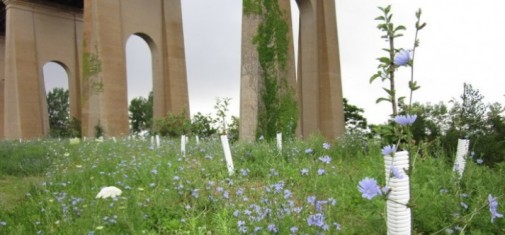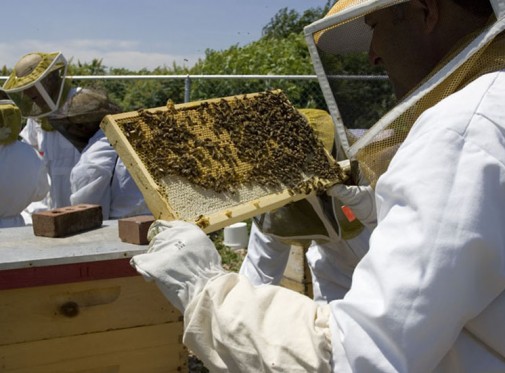Resources
What is Food Urbanism?
Upcoming events
You don't have access to any upcoming eventsSearch
Support

- FUI is supported by a grant from the Swiss National Science Foundation under the National Research Programme NRP 65 "New Urban Quality"
Typology >Jardin et parc public
Description
Afin de fournir la meilleure qualité urbaine possible à ses citoyens, le gestionnaire des espaces publics propose des activités de loisir en organisant du maraîchage dans une partie de ses parcs. Le maraîchage devient partie prenante du paysage urbain et les parcs instaurent le jardinage-encadré comme jadis les promenades et les pique-niques sur l’herbe.
Organisation spatiale
Le parc urbain est organisé de manière à permettre aux personnes la libre utilisation de parcelles publiques, clairement identifiées, et à des fins de production maraîchère. La disposition des parcelles est programmée de manière à permettre une mise en culture au fur et à mesure des besoins. Ces espaces sont ouverts à l’activité selon des horaires particuliers et participent à la beauté du parc.
Critère de production
Les citoyens volontaires se présentent au jardinier, gestionnaire du parc, qui les oriente vers un travail maraîcher adapté en cours de réalisation. Ce gestionnaire a reçu une formation professionnelle adaptée au management de bénévoles et leur fournit les outils nécessaires. Les citoyens participent alors à la réalisation d’une tâche productive globale à long terme et acquièrent directement sur le terrain les compétences de travail.
Dimension sociale
Les activités habituelles des parcs continuent, la production alimentaire constitue une nouvelle offre de l’espace public. Pour les citoyens qui y participent, la répétitivité du travail permet une rapide compréhension globale des actions requises et permet au corps de se concentrer sur ses gestes et ses postures. Cela permet d’acquérir un rythme et de développer une cadence en phase avec la nature présente. Cette simplicité des tâches donne une grande efficacité au travail manuel et le travail d’équipe permet une unité favorisant la rencontre et la compréhension entre différentes cultures.
Contexte urbain
Ces grands espaces verts sont précieux dans les villes. Au sein de la ville moderne de type européen, les grands parcs ont toujours eu une utilité de reconnexion à la nature, nécessaire équilibre pour l’homme des espaces minéralisés. Ils développent leur vocation historique en intégrant la participation citoyenne aux activités jardinières et rendent possibles de nouvelles interactions faunistiques par les plantes productives.
Opportunités / contraintes
Les motivations pour le jardinage sont autres que la simple économie d’argent (sondage FUI figure18) qui arrive en avant dernière position après le partage des expériences, l’activité physique, la sauvegarde de l’environnement et le résultat concret de l’activité, c’est-à-dire, la récolte et l’effet de son travail sur le jardin, immédiat comme futur. L’information des citoyens pour l’usage alimentaire du parc doit être assurée et les jardiniers formés aux cultures alimentaires.
Yes to local urban agriculture – No to a temporary parking lot!!!
“Save R-URBAN, an internationally acclaimed professional and citizen initiative of resilient regeneration in Colombes, near Paris, and persuade the municipality and other authorities of the general interest of preserving this project whose main site in Colombes is currently threaten to …
+ read more
Les Parties, Yverdon-les-bains

L’équipe pluridisciplinaire pour Les Parties, pilotée par Urbaplan avec la participation de VWA pour la thématique paysage, a abordé l’urbanisation d’un espace actuellement agricole, pris entre la frange urbaine existante et le viaduc. Le programme prévu pour ce secteur inclut …
+ read more
Guerrilla Grafters: Splicing fruit-Bearing Branches Onto City Trees

In 2013, Vancouver completed the largest urban orchard in North America. The site, a former gas station, is rented by Sole Food from the city of Vancouver for $1 per year. Situated near a train station, this once abandoned site …
+ read more
NYC Public Access Orchard

Newtown Pippin Restoration are reintroducing and cultivating the historically significant Newton Pippin apple tree in New York by donating trees to local community gardens, schools, environmental groups and other public spaces to ensure the trees can be publicly accessed.
The …
+ read more
Brick City Urban Farms and EarthBoxes

Brick City Urban Farms began using EarthBoxes when they created an urban farm (with the help of the newly elected mayor) on an unused parcel of land in Newark. The soil on this plot was polluted and unsuitable for growing …
+ read more
Downsview Park and FoodCycles CSA

Downsview Park International Design Competition was launched over a decade ago and since then the Park has realized its vision and put in place a foundation for a sustainable future. The Park is a recreational greenspace incorporating both open space, …
+ read more
Community Vehicular Reclamation Project

A car towed from the junkyard was filled with soil, the body work painted, planted with herbs, flower and vegetables then parked up on the street in the Kensington Market area of Toronto. This installation was one of the many …
+ read more
Better Bankside Urban Forest

Bankside Urban Forest is supported by Better Bankside BID, an independent, business-owned and led company, that seeks to improve a given location for commercial activity. The members are 460 companies in the BID area who pan an annual ‘levy’. They …
+ read more
Farview Park, RIVERFIRST Project

The winning entry for the Minneapolis Riverfront Competition, the RIVERFIRST Project establishes a design framework to address 4 challenges for the 21st century: water, health, mobility and green economy. RIVERFIRST design initiatives function at multiple scales to link larger natural, …
+ read more
Edible Park, City Farm Herweijerhoeve, Zuiderpark

The project is part of the Hague city farm Herweijerhoeve in the Zuiderpark and the Amateur Market Gardener’s Association ‘Nut en Genoegen’. Permaculture is used although the goal is primarily educational and artistic. The public is encouraged to interact with …
+ read more
Edible Estates #8 – Lenape Edible Estate

Part of the Edible Estates project by Fritz Haeg, this garden is described as “a demonstration garden, part experimental laboratory and part educational display”. Haeg and his partners use edible native plants to remind visitors of a geographic history which …
+ read more
Curran House

Curran House is a high density affordable housing structure in San Francisco’s Tenderloin neighborhood. There is a garden on the first floor entrance which leads to a courtyard in the back, serving as a “decompression” garden as one moves from …
+ read more
Alemany Farms

Alemany Farms is a volunteer-run farm set between residential areas, playfields and a highway. There are in-ground plantings, raised beds, hoop houses, and areas for educational groups to gather.
The Alemany Farm is a non-profit organization which uses the farm …
+ read more
Loutet Park

The Loutet Park Farm is a pilot project which seeks to address a wide range of issues of urban quality through the creation of an urban farm in an under-used portion of a public park in Vancouver, British Columbia. The …
+ read more
Union Street Orchard

The Union Street Orchard was a temporary installation of floating and in-ground agriculture. It’s construction was part of the London Festival of Architecture and transformed a parking lot in the SE1 neighborhood of London into an urban orchard and community …
+ read more



